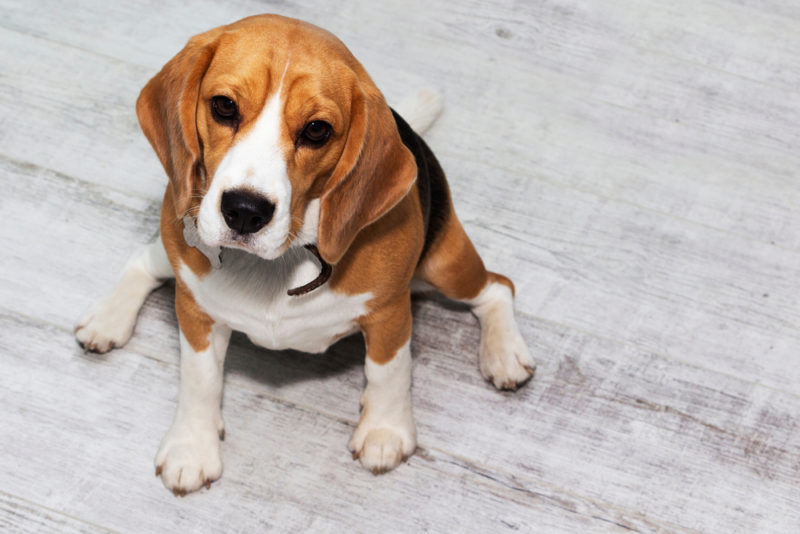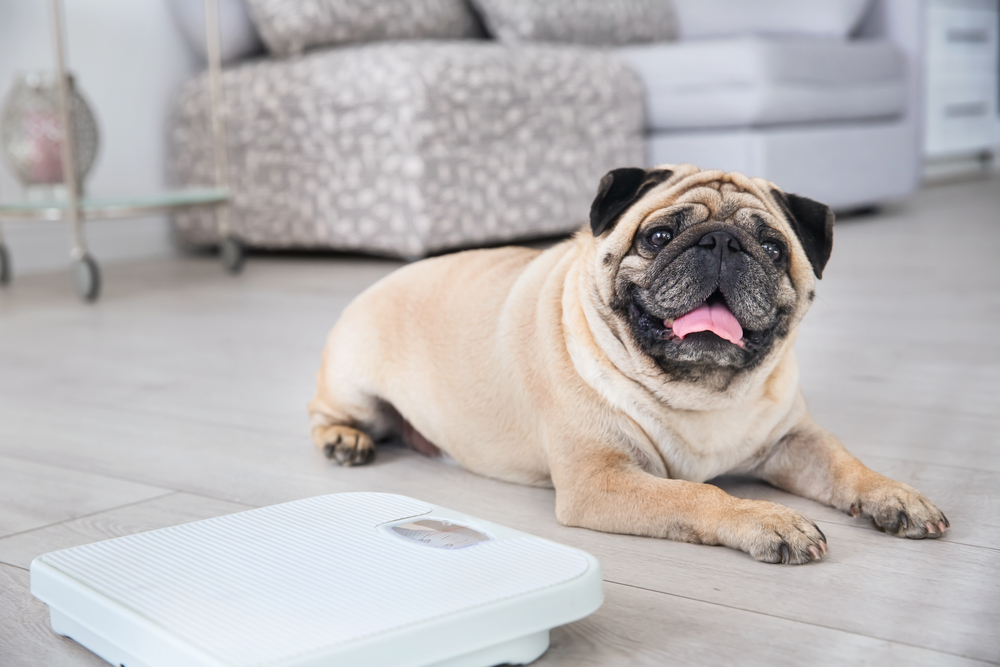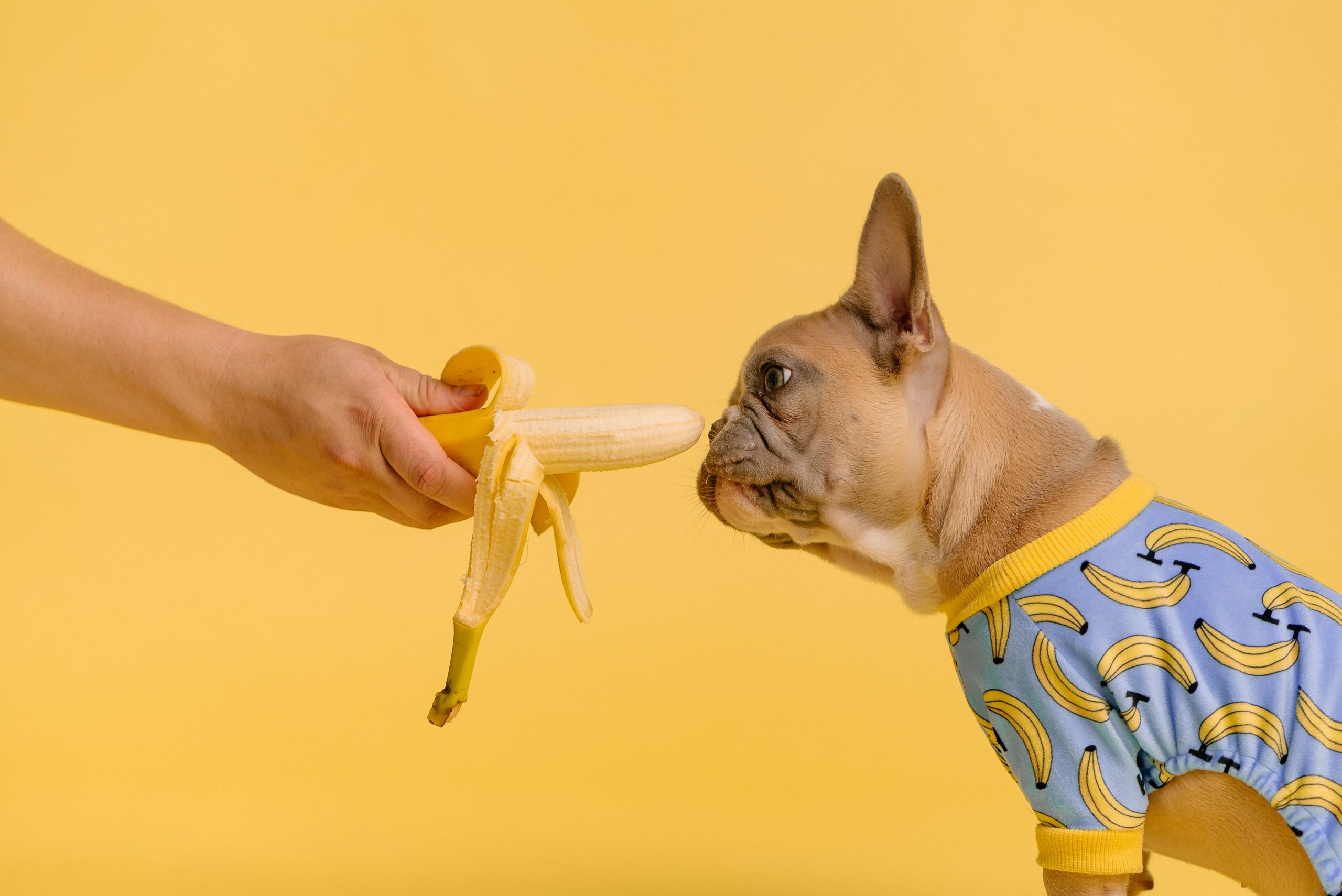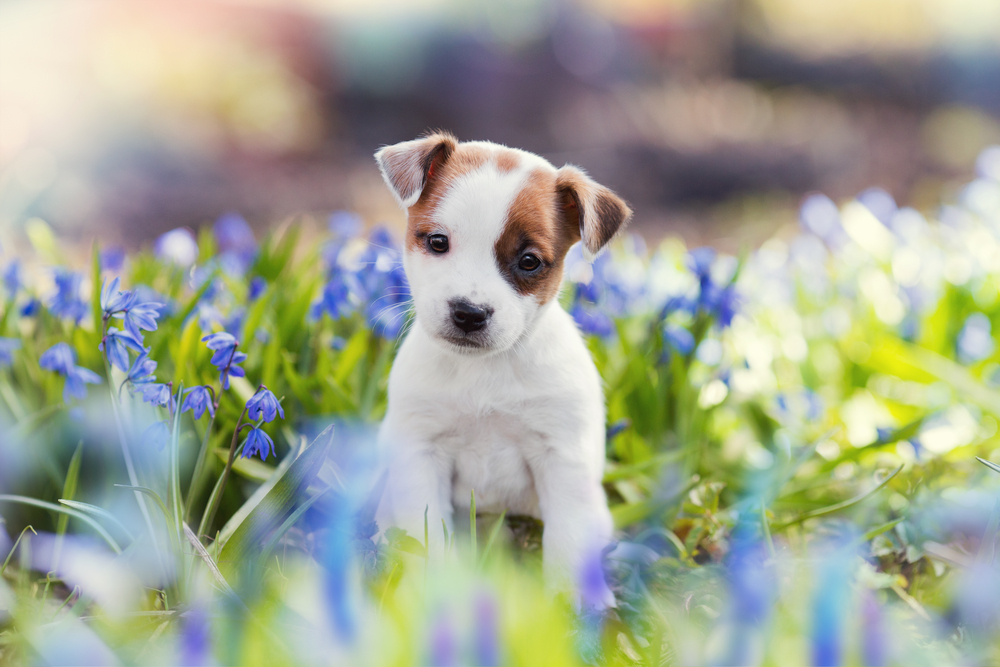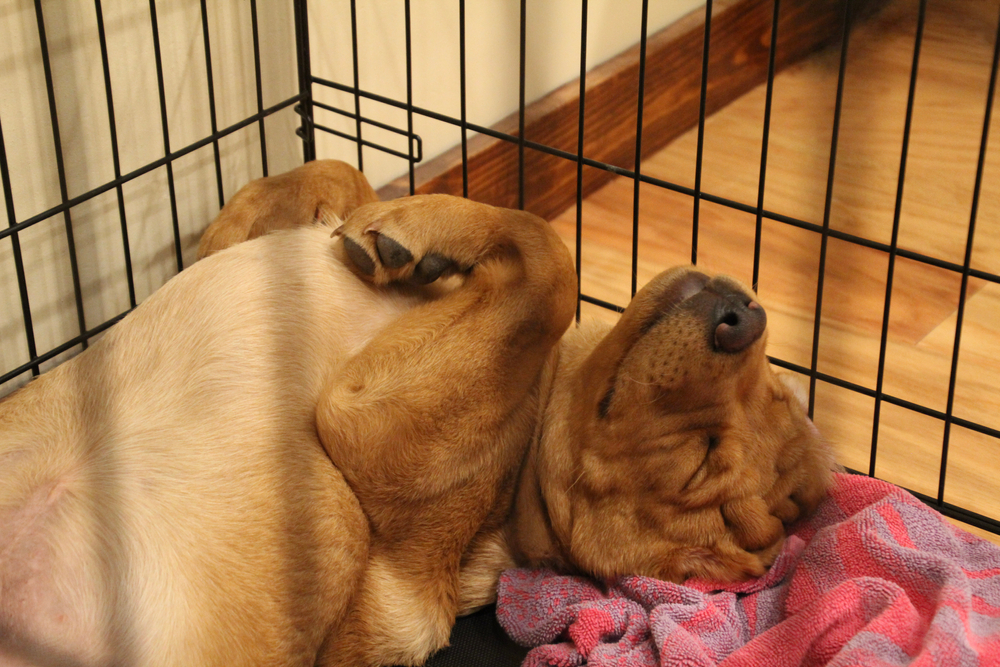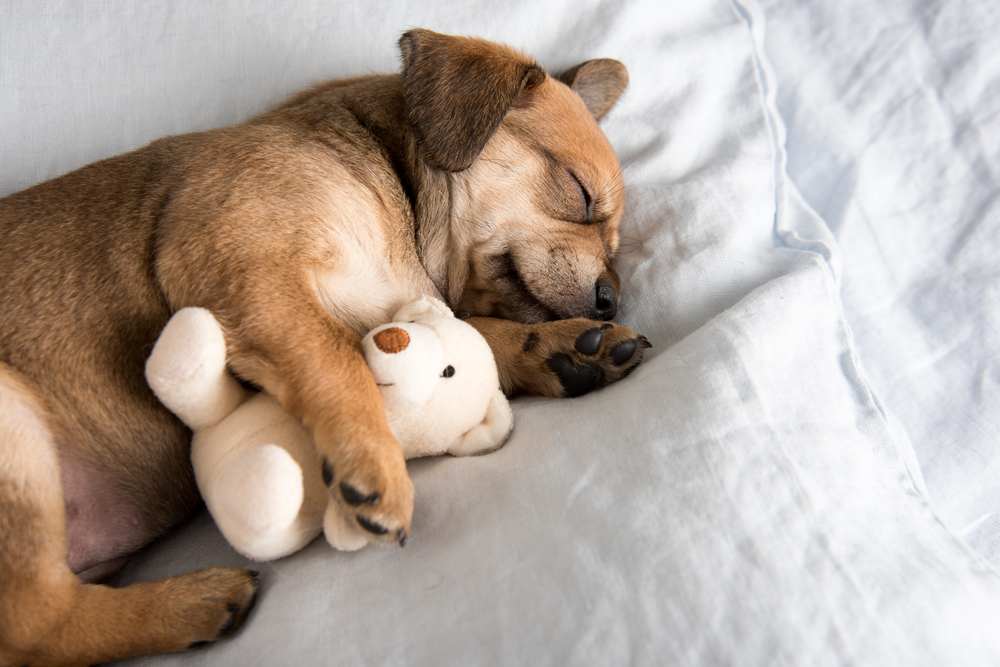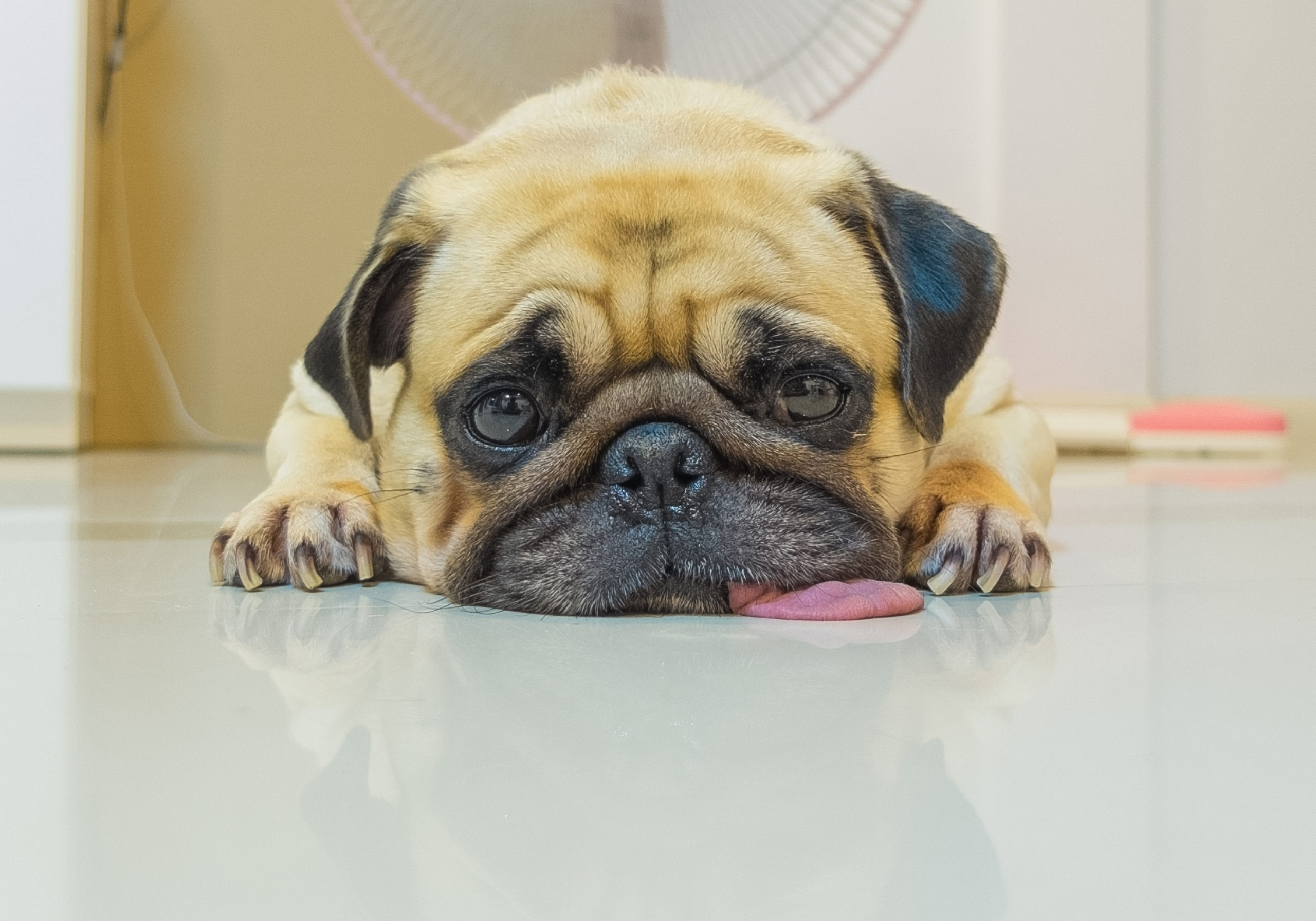Advertisements online and on TV usually display dog food bowls brimming with kibble and round-bodied dogs chowing down happily. We’ve grown accustomed to these images as normal representations of canine happiness and health, and dog owners are more likely to think that an overweight dog is, in fact, a healthy dog. However, weigh-ins at annual veterinary wellness appointments tell a bit of the reality we see as veterinarians: weight gain is common, and dogs being classified as obese occurs more frequently than we would like to see! In fact, in North America about 25% of adult dogs are obese, and 50% of dogs are considered overweight!
Carrying extra pounds may be considered endearing and adorable, however, when we discuss the serious impacts that long term weight gain and obesity can have on the health of our pets, it becomes clear that a fit and trim dog is best positioned for a long and healthy life.
How Do You Know If Your Dog Is Overweight?
Just like in our own human bodies, canine weight gain and changes in body mass over time can be hard to detect! Humans do have some daily indicators, though … tighter jeans and struggles to get that belt buckle hooked might hint at some extra padding. Since dogs don’t wear clothes, how do we really tell if they are overweight?
Veterinarians take into account breed standards and also use a handy Body Condition Score (BCS) Chart to assess key points around a dog’s body looking for the presence of extra fat deposits. At your dog’s next vet appointment, watch carefully as the vet is talking to you. It may look like they are petting and massaging your dog, but they are probably actually assessing their body condition and feeling around with their fingers for abnormalities… and taking notes!
Indicators of a Dog’s Body Condition:
- Ribs – Ideally, the ridges of the ribs should be felt easily by running hands down each side of the dog’s chest. If ribs are not present with a light touch, and fingers need to poke in a bit in order to find them (fluffy hair aside), this means that excess layers of fat exist.
- Waist – Dogs can have an hourglass appearance too! Looking down at their back from above, a nice indentation around the dog’s natural waist is ideal. If you are just seeing a rectangle from above, this can mean that there are extra fat deposits filling in space around the muscles.
- Abdominal Tuck/Distention – Take a look at your dog from across the room. They should still exhibit that hourglass appearance– from the side view, pay attention to the hips and abdomen. A nice tuck up just before the legs should be appreciated. A potbelly or rectangular appearance of the body can indicate abdominal enlargement and extra fat storage.
- Fat Pads – Extremely overweight dogs will have extra fat deposits over the base of the tail, along the lower back, and even around the neck, shoulders, and legs. All body contours will be obscured, and the dog will take on a round shape. They will often exhibit an altered gait and difficulty moving, too.
Health Problems That Arise From Weight Gain in Dogs
Dogs LOVE food and are so cute and happy when they are fat — why is it so important to keep them in an ideal healthy body condition? Research in dogs has proven that a healthy body condition maintained over time will lead to a longer and more comfortable life, with a decreased risk of health issues associated with being overweight or obese. Keeping a dog at the ideal body condition score of a 4 or 5 (on a scale of 1-9) based on the BCS chart, will improve their longevity by 1-2 years and maintain their overall happiness and comfort level, especially during those senior years. Aside from the changes that arise from long-term stress on the joints and bones due to carrying around extra weight, fat is known to be biologically active as well, secreting inflammatory hormones that can actually contribute to and cause diseases. The following are some diseases and health conditions that have been associated with obesity:
– Skin Problems
– Arthritis, back injuries, and mobility issues
– Diabetes
– Kidney and liver disease
– Hypertension and Heart Disease
– Breathing problems
– Some types of cancer
– Complications with anesthesia
Health Conditions That Can Cause Weight Gain and Changes in Body Condition
To complicate things a bit, sometimes a dog’s weight gain is not simply due to eating too many treats or lack of exercise. Sometimes it is actually an indicator of a disease! Dogs will retain fluid and fat due to certain disease processes, the most common being Cushing’s Disease (overactive adrenal glands) and Hypothyroidism (underactive thyroid gland). If your family veterinarian has noticed that your dog’s weight gain correlates with some classic changes in the skin and coat, abdominal appearance (“potbelly”), energy level, water consumption, or urination habits, the recommendation may be made to run some further blood and urine testing in order to rule out a metabolic cause of the weight gain. It is very important to identify any health conditions as a cause of dog weight gain before immediately jumping to lifestyle changes so that appropriate medical treatment is initiated if needed.
How to Keep Your Dog at a Constant and Healthy Weight
Of course, the easiest way to ensure that your dog does not suffer from the complications of long-term obesity is for pet parents to keep their dog’s diet, exercise, and weight constant and regulated. Dogs thrive with a predictable schedule. Once they reach adulthood, maintaining a steady diet, walking or playing outdoors 2-3 times per day (1-2 hours ideally!), and monitoring their treat intake will help keep them at a steady body weight.
Your veterinarian can assist with estimating a healthy ideal weight range for your adult dog to help track any fluctuations and keep trends in check. Home weigh-ins are useful too! If your dog is small enough to pick up, you can use a scale at home; just weigh yourself, then weigh yourself carrying your pup, and subtract!
Visits with your veterinarian every 6 months to 1 year are important for tracking weight changes and gauging if tweaks in your dog’s feeding and exercise schedule are needed. For example, as lifestyles shift and dogs advance in age, there may be some necessary changes in caloric intake or exercise that are recommended by your family veterinarian to maintain your dog’s health. For assistance with dietary changes and needs as dogs enter their senior years (7+ years old), or if you are curious about how much to feed a dog daily, your veterinarian is also a great resource for diet planning and advice.
What to Do If Your Dog is Overweight or Obese
If it has been determined that your dog is surpassing their ideal weight and lifestyle habits are likely the culprit, what to do now? Weight loss in dogs can be a challenge for both dog and pet parent, but it is entirely achievable with determination and consistency! Are you asking yourself: Is my dog overweight? If you have a hunch that your dog might be overweight and would like guidance on how to address weight gain in dogs, your family veterinarian will gladly devise a diet plan to help you both through the process.
Your veterinarian will start out by estimating the ideal weight goal and calculate the caloric requirement for a healthy rate of weight loss. Success can come with shifting to a lower calorie/higher fiber diet for dogs or even a reduced-calorie prescription diet, along with accurately measuring volumes of food at each meal, and maintaining a regular dog exercise plan at least twice daily for 20 minutes at a time. Restricting treats to an acceptable predetermined amount, and monthly weigh-ins at home or with your vet are also important. A healthy approach to exercise, feeding, and weight loss will help establish better long-term management and a happier dog and pet parent!
Keeping It All Balanced
Dogs tend to have an intense love for food, and their instinctual drive to always be looking for snacks makes it very easy to overfeed and treat them at their request. Learning the happy balance for feeding, exercise, and treat-ing, paired with veterinary checkups and body condition assessments will ensure that your dog is maintaining their healthiest weight over its lifetime– resulting in longevity and happiness for your beloved buddy!
Our AskVet Veterinarians are available to discuss all of your pet’s needs 24 hours a day, 7 days a week. Whether you have an immediate need or are looking to improve your pet’s overall wellbeing, just sign into your account and one of our friendly and knowledgeable veterinary experts will attend to your needs, no appointment required!
Written by:
Alexa Waltz, DVM
Dr. Waltz was raised near the beaches of Southern California but has spent her adult life living all over the beautiful United States while serving in the military and as a military spouse. She left California for the first time to pursue a career as a veterinarian at Louisiana State University School of Veterinary Medicine and graduated as a Doctor of Veterinary Medicine in 2006. She was accepted into the US Army Health Professionals Scholarship Program during vet school and upon graduation spent her military years as a veterinarian in San Diego working for the US Marine Corps and US Navy Military Working Dog programs as well as caring for pets of service members. After her military service, she became a civilian veterinarian and continued as a small animal general practitioner at clinics in California, Rhode Island, Colorado, and Maryland. Dr Waltz loves to see her “in person” patients just as much as communicating with and assisting pet parents virtually on AskVet. Dr Waltz is also a Mom to 3 humans, 2 guinea pigs, and 1 Australian Shepherd and in her spare time she loves traveling, adventures, exercising, and doing just about anything out in nature!

